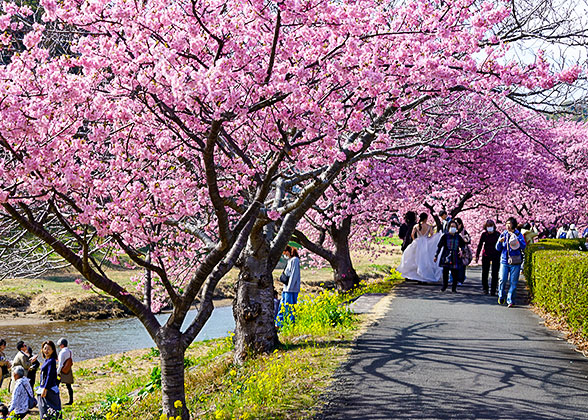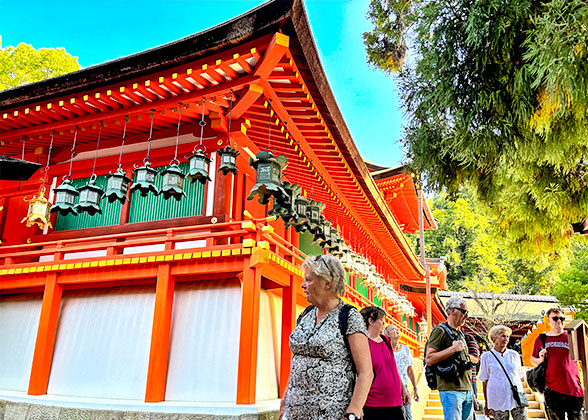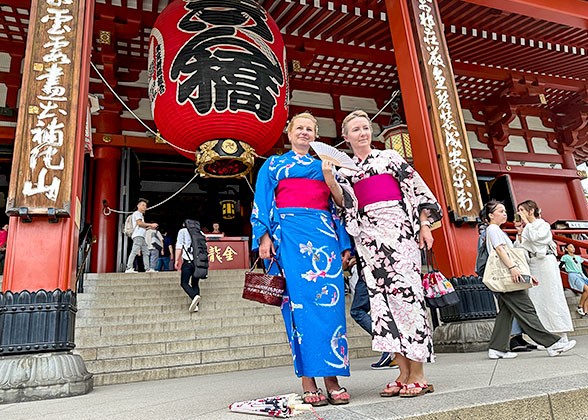- Attractions
- Weather
- Photos
Fukuoka Weather
![]() Climatic Zone: subtropical monsoon climate
Climatic Zone: subtropical monsoon climate
 Average Temperature: 13 - 21℃ (55.4 - 69.8℉)
Average Temperature: 13 - 21℃ (55.4 - 69.8℉)
 Average Sunshine Hours: 5.1 h
Average Sunshine Hours: 5.1 h
 Warmest Month: August: 25 - 32 ℃ (77 - 89.6℉)
Warmest Month: August: 25 - 32 ℃ (77 - 89.6℉)
 Coolest Month: January: 3 - 10℃ (37.4 - 50℉)
Coolest Month: January: 3 - 10℃ (37.4 - 50℉)
 Rainiest Months: June: 213.9 mm in 13 days; July: 253.2 mm in 12 days
Rainiest Months: June: 213.9 mm in 13 days; July: 253.2 mm in 12 days
 What is the Fukuoka weather like?
What is the Fukuoka weather like?
(1) Four distinct seasons: mild winters with a little snow or rain, hot and rainy summers, and spring and autumn with comfortable temperature and moderate rainfall;
(2) More pleasant compared with many inland places at the same latitude: the average annual temperature is 17°C;
(3) Adequate precipitation: the annual precipitation is about 1,500 mm, and July and August are the rainy season. In addition, Fukuoka may experience typhoons from August to October.
It is springtime in Fukuoka, when the weather is warm and rainfall is low. Moreover, there are various traditional festivals and celebrations in these months, such as Hakata Dontaku, the largest civic festival in Japan. From late March to early April, you can see cherry blossoms in Fukuoka.
September – November
These months have mild sunshine, favorable temperature and blue sky, perfect to go out and travel. Besides, you can admire the unique and beautiful autumn scenery- red maple leaves during this period.
• Read more: Best Time to Visit Japan & Japan Weather
|
|
|




Spring: March to May
 Weather: warm and suitable for traveling
Weather: warm and suitable for traveling Temperature: 6-24℃ (42.8-75.2℉)
Temperature: 6-24℃ (42.8-75.2℉) Rainfall: 314 mm
Rainfall: 314 mm Rainy days in total: 32 days
Rainy days in total: 32 daysOverall, the weather of Fukuoka is pleasant in spring, with the highest temperature of 14-24°C (57.2-75.2°F) and the lowest of 6-16°C (42.8-60.8°F). March may be a little colder than the other two months, but the temperature is on the rise. In April and May, the temperature reaches a comfortable level. The rainfall is also moderate in this season, with an average of about 10 rainy days per month. Spring is the time when the cherry blossoms are in full bloom, and the best time to see them in Fukuoka is from mid-March to early April.
See more: What Months are Cherry Blossom Season in Japan?
 Clothes to Wear:
Clothes to Wear:
In daytime of spring mostly, you can wear thin knitwear, hoodies, or long-sleeve T-shirts plus trench coats or jackets, and together with jeans or sweatpants. However, in the early days of the season and some cool mornings and nights, thick overcoats are needed. Besides, sneakers and walking shoes are recommended.
 Travel Recommendation and Tips:
Travel Recommendation and Tips:1. Fukuoka Castle, Maizuru Park, and Nishi Park are representative spots to enjoy cherry blossoms.
2. Hakata Dontaku is a grand celebration in May, whose highlight is the Dontaku parade by over 20 thousand of people dressed in colorful traditional costumes.
3. Nokonoshima Island is full of various flowers in spring.

Cherry Blossoms in Maizuru Park
|
Summer: June to August
 Weather: hot and rainy
Weather: hot and rainy Temperature: 21-32℃ (69.8-89.6℉)
Temperature: 21-32℃ (69.8-89.6℉) Rainfall: 674.7 mm
Rainfall: 674.7 mm Rainy days in total: 36 days
Rainy days in total: 36 days
In summer, Fukuoka climate is hot and changeable. Specifically, June and July are the plum rainy season, when Fukuoka rains a lot, and the rainfall reaches 466.1 mm in total from 25 rainy days. As a result, humidity is high in the two months, reaching 75% in both. During this period, the weather is hot and stuffy. Starting from mid-July, Fukuoka comes to the end of the rainy season and steps into the hottest time, when the high temperature rises above 30℃ (86℉) nearly every day. This kind of weather lingers till late August.
See more: Everything You Need to Know about Rainy Season in Japan
 Clothes to Wear:
Clothes to Wear:Be sure to wear clothes as thin as possible, and T-shirts, short shirts, skirts, shorts, dresses, and light pants are recommended. Likewise, breathable shoes like sandals and thin sneakers should be brought. Besides, sun protection items and raingear are necessary on these days.
 Travel Recommendation and Tips:
Travel Recommendation and Tips:1. During summer, the Fireworks Festival is celebrated in many places of Fukuoka. In 2024, the celebrations are mostly concentrated in July and August, hoping to give your 2026 trip a reference.
2. Hakata Gion Yamakasa, which takes place every July, is the highlight of summer. During this exciting festival, teams of men in traditional costumes will carry huge decorated floats and race through the streets.
3. Do not miss the Kushida Shrine, which is the oldest shrine in Fukuoka and the holding place of Hakata Gion Yamakasa in the first half of July.
4. Summer is the time to go to Itoshima Peninsula to enjoy the sea water and bright sunshine.

Hakata Gion Yamakasa
|
Autumn: September to November
 Weather: pleasant with moderate temperature and humidity
Weather: pleasant with moderate temperature and humidity Temperature: 9-28℃ (48.2-82.4℉)
Temperature: 9-28℃ (48.2-82.4℉) Rainfall: 298.8 mm
Rainfall: 298.8 mm Rainy days in total: 29 days
Rainy days in total: 29 days
 What to Wear:
What to Wear:Pack thin clothes like long-sleeve T-shirts, blouses, thin knitwear, jeans, and sweatpants for early Autumn; while jackets, trenchcoats and sweaters for late Autumn. Sneakers are needed these months.
 Travel Recommendation and Tips:
Travel Recommendation and Tips:1. Autumn is a good time for outdoor hiking, so you are advised to visit Ohori Park.
2. If you want to appreciate red maple leaves, Mount Hiko and Mount Homan are good choices.
3. On sunny days, you can go to the 234-meter-high (768 feet) observation deck of the Fukuoka Tower to enjoy the beautiful sunset and night scenery of Fukuoka.

Colorful Leaves in Fukuoka
|
Winter: December to February
 Weather: cold with a little precipitation
Weather: cold with a little precipitation Temperature: 3-12℃ (37.4-53.6℉)
Temperature: 3-12℃ (37.4-53.6℉) Rainfall: 194.1 mm
Rainfall: 194.1 mm Rainy days in total: 32 days
Rainy days in total: 32 days
 Clothes to Wear:
Clothes to Wear:On these cold days, you need wool overcoats, downcoats and winter pants. Thick shoes like boots and thick sneakers are suitable. Other than these, hats and scarves can effectively protect you from coldness.
 Travel Recommendation and Tips:
Travel Recommendation and Tips:1. Dazaifu Tenmangu Shrine is a perfect destination for your winter trip in Fukuoka, where you can visit characteristic shrine buildings and enjoy beautiful plum blossoms.
2. Do not forget to enjoy hot springs in the cold winter.
3. On cold days, Canal City Hakata, an indoor comprehensive shopping center, is a good shelter, where you can go shopping and taste delicious food.

Canal City Hakata
|
You May Like
-
 7 Days Best Japan Private Tour of Tokyo - Mt. Fuji - Tokyo - Kyoto - Nara - Osaka from USD2401
7 Days Best Japan Private Tour of Tokyo - Mt. Fuji - Tokyo - Kyoto - Nara - Osaka from USD2401 -
 11 Days Mini Group Tour to Tokyo - Hakone (Mt. Fuji) - Kyoto - Nara - Osaka - Hiroshima... from USD3554
11 Days Mini Group Tour to Tokyo - Hakone (Mt. Fuji) - Kyoto - Nara - Osaka - Hiroshima... from USD3554 -
 8 Days Mini Group Tour: Tokyo - Hakone & Mt. Fuji - Kyoto - Nara - Osaka - Hiroshima - Osaka from USD2771
8 Days Mini Group Tour: Tokyo - Hakone & Mt. Fuji - Kyoto - Nara - Osaka - Hiroshima - Osaka from USD2771


